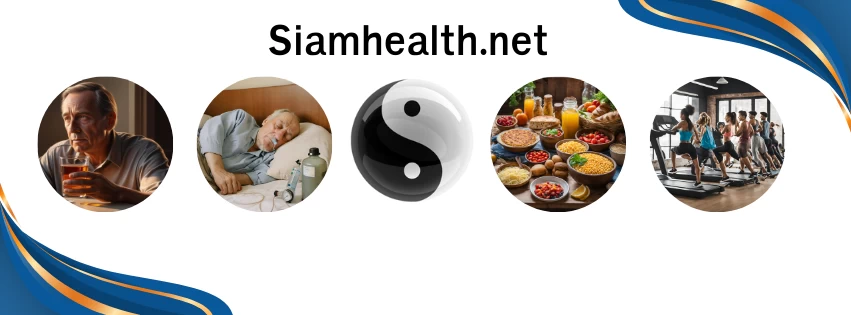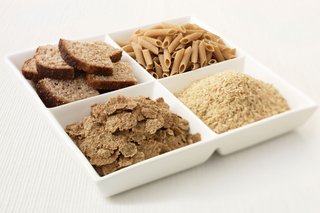
หน้าหลัก | สุขภาพดี | สุภาพสตรี | การแปลผลเลือด | โรคต่างๆ | วัคซีน | อาหารเพื่อสุขภาพ
อาหารจำพวกแป้งและคาร์โบไฮเดรต
อาหารประเภทแป้งเป็นแหล่งคาร์โบไฮเดรตหลักของเราและมีบทบาทสำคัญในการรับประทานอาหารที่ดีต่อสุขภาพ
อาหารประเภทแป้ง เช่น มันฝรั่ง ขนมปัง ข้าว พาสต้า และซีเรียล ควรมีปริมาณมากกว่าหนึ่งในสามของอาหารที่คุณรับประทาน ดังที่แสดงโดยคู่มือ Eatwell.
ในส่วนที่คุณทำได้ ให้เลือกพันธุ์โฮลเกรนและกินมันฝรั่งทั้งเปลือกเพื่อเพิ่มไฟเบอร์
เราควรกินอาหารจำพวกแป้งทุกวันเป็นส่วนหนึ่งของกอาหารที่ดีต่อสุขภาพและสมดุล.
อาหารประเภทแป้งเป็นแหล่งพลังงานที่ดีและเป็นแหล่งสารอาหารหลักในอาหารของเรา นอกจากแป้งแล้ว ยังมีไฟเบอร์ แคลเซียม เหล็ก และวิตามินบีอีกด้วย
บางคนคิดว่าอาหารประเภทแป้งทำให้อ้วน แต่กรัมต่อกรัมมีแคลอรี่น้อยกว่าครึ่งหนึ่งของไขมัน
เพียงระวังไขมันที่เพิ่มขึ้นที่คุณใช้เมื่อคุณปรุงอาหารและเสิร์ฟ เพราะจะทำให้เนื้อหาแคลอรี่เพิ่มขึ้น
อาหารจำพวกแป้งโฮลเกรนและมันฝรั่ง (โดยเฉพาะอย่างยิ่งเมื่อรับประทานโดยเปิดผิวหนัง) คือแหล่งไฟเบอร์ที่ดี.
ไฟเบอร์เป็นชื่อเรียกของสารต่างๆ ที่พบในผนังเซลล์ของผัก ผลไม้ ถั่วและเมล็ดธัญพืช
ไฟเบอร์ที่ไม่สามารถย่อยได้ช่วยให้อาหารและของเสียอื่นๆ เคลื่อนผ่านลำไส้
หนังมันฝรั่ง ขนมปังโฮลเกรน และอาหารเช้าซีเรียล ข้าวกล้อง และพาสต้าโฮลวีตล้วนเป็นแหล่งที่ดีของไฟเบอร์ชนิดนี้
ไฟเบอร์สามารถช่วยให้ลำไส้ของคุณแข็งแรงและช่วยให้คุณรู้สึกอิ่ม ซึ่งหมายความว่าคุณมีโอกาสน้อยที่จะกินมากเกินไป
สิ่งนี้ทำให้อาหารประเภทแป้งโฮลเกรนและมันฝรั่งที่รับประทานโดยลอกเปลือกออกเป็นทางเลือกที่ดีหากคุณกำลังพยายามลดน้ำหนัก.
ไฟเบอร์บางประเภทที่พบในผักและผลไม้ เช่น แอปเปิ้ล แครอท มันฝรั่ง และในข้าวโอ๊ตและเมล็ดถั่วสามารถย่อยได้บางส่วนและอาจช่วยลดปริมาณคอเลสเตอรอลในเลือดได้
เคล็ดลับเหล่านี้สามารถช่วยให้คุณเพิ่มปริมาณอาหารประเภทแป้งในอาหารของคุณได้
มันฝรั่ง
มันฝรั่งเป็นทางเลือกที่ดีสำหรับอาหารประเภทแป้งและเป็นแหล่งพลังงาน ไฟเบอร์ วิตามินบี และโพแทสเซียมที่ดี
ในสหราชอาณาจักร เราได้รับวิตามินซีจำนวนมากจากมันฝรั่งเช่นกัน แม้ว่ามันฝรั่งจะมีวิตามินซีเพียงเล็กน้อย แต่โดยทั่วไปแล้วเรารับประทานกันมาก พวกมันคุ้มค่ากับเงินที่เสียไปและเป็นทางเลือกที่ดีต่อสุขภาพ
แม้ว่ามันฝรั่งจะเป็นผัก แต่ในสหราชอาณาจักรเรากินมันเป็นส่วนหนึ่งของอาหารที่เป็นแป้งเป็นส่วนใหญ่ และพวกมันเป็นแหล่งคาร์โบไฮเดรตที่ดีในอาหารของเรา
ด้วยเหตุนี้มันฝรั่งจึงไม่นับรวมกับของคุณผักและผลไม้ห้าส่วนต่อวันแต่อาจมีบทบาทสำคัญในการรับประทานอาหารของคุณ
มันฝรั่งเป็นทางเลือกที่ดีต่อสุขภาพเมื่อต้ม อบ บด หรือคั่วโดยใช้ไขมันหรือน้ำมันเพียงเล็กน้อยและไม่เติมเกลือ
เฟรนช์ฟรายและมันฝรั่งทอดทอดในน้ำมันหรือเสิร์ฟพร้อมเกลือไม่ใช่ทางเลือกที่ดีต่อสุขภาพ
เมื่อปรุงหรือเสิร์ฟมันฝรั่ง ให้ใช้สเปรดที่มีไขมันต่ำหรือไขมันไม่อิ่มตัวเชิงซ้อน หรือใช้น้ำมันไม่อิ่มตัวปริมาณเล็กน้อย เช่น น้ำมันมะกอกหรือน้ำมันดอกทานตะวัน
สำหรับมันบด ให้ใช้นมพร่องมันเนย เช่น นมกึ่งพร่องมันเนย ไขมัน 1% หรือพร่องมันเนย แทนนมสดหรือครีม
ทิ้งเปลือกมันฝรั่งไว้หากเป็นไปได้เพื่อให้ไฟเบอร์และวิตามินมากขึ้น ตัวอย่างเช่น กินเปลือกเมื่อคุณต้มหรืออบมันฝรั่ง
ถ้าคุณต้มมันฝรั่ง สารอาหารบางอย่างจะรั่วไหลออกมาในน้ำ โดยเฉพาะอย่างยิ่งถ้าคุณปอกเปลือกออกแล้ว หากต้องการหยุดสิ่งนี้ให้ใช้น้ำให้เพียงพอเพื่อปิดฝาและปรุงให้นานเท่าที่ต้องการ
การเก็บมันฝรั่งไว้ในที่เย็น มืด และแห้ง หรือในตู้เย็นจะช่วยหยุดการแตกหน่อได้ อย่ากินมันฝรั่งที่มีสีเขียว เสียหาย หรือแตกหน่อ เพราะอาจมีสารพิษที่อาจเป็นอันตรายได้
ขนมปัง โดยเฉพาะอย่างยิ่งขนมปังโฮลมีล ยุ้งฉาง สีน้ำตาล และแบบมีเมล็ด เป็นทางเลือกที่ดีต่อสุขภาพในการรับประทานเป็นส่วนหนึ่งของอาหารที่สมดุล
โฮลเกรน โฮลมีล และขนมปังสีน้ำตาลให้พลังงานแก่เรา และมีวิตามินบี วิตามินอี ไฟเบอร์ และแร่ธาตุหลากหลายชนิด
ขนมปังขาวยังมีส่วนประกอบของวิตามินและแร่ธาตุแต่มีไฟเบอร์น้อยกว่าขนมปังโฮลเกรน โฮลมีล หรือขนมปังสีน้ำตาล หากคุณชอบขนมปังขาว ให้มองหาตัวเลือกที่มีไฟเบอร์สูงกว่า
บางคนหลีกเลี่ยงขนมปังเพราะกังวลเกี่ยวกับการมีการแพ้อาหาร หรือแพ้ข้าวสาลี หรือพวกเขาคิดว่าขนมปังทำให้อ้วน
อย่างไรก็ตาม การตัดอาหารประเภทใดก็ตามออกจากอาหารของคุณโดยสิ้นเชิง อาจหมายความว่าคุณพลาดสารอาหารหลายชนิดที่จำเป็นต่อการมีสุขภาพที่ดี
หากคุณกังวลว่าคุณมีอาการแพ้ข้าวสาลีหรือแพ้ข้าวสาลี ให้ปรึกษาแพทย์
ขนมปังสามารถเก็บไว้ที่อุณหภูมิห้องได้ ปฏิบัติตามวันที่ "ควรบริโภคก่อน" เพื่อให้แน่ใจว่าคุณรับประทานสดใหม่
ผลิตภัณฑ์ธัญพืชทำมาจากธัญพืช ธัญพืชโฮลเกรนมีส่วนช่วยให้ได้รับธาตุเหล็ก ไฟเบอร์ วิตามินบี และโปรตีนในแต่ละวัน ตัวเลือกที่มีเส้นใยสูงสามารถปล่อยพลังงานได้ช้า
ข้าวสาลี ข้าวโอ๊ต ข้าวบาร์เลย์ ข้าวไรย์ และข้าว เป็นธัญพืชที่หาได้ทั่วไปซึ่งสามารถรับประทานเป็นโฮลเกรนได้
ซึ่งหมายความว่าผลิตภัณฑ์จากธัญพืชที่ประกอบด้วยข้าวโอ๊ตหรือข้าวโอ๊ต เช่น โจ๊ก และผลิตภัณฑ์โฮลวีตเป็นตัวเลือกอาหารเช้าที่ดีต่อสุขภาพ
ข้าวบาร์เลย์ คูสคูส ข้าวโพด และมันสำปะหลังก็นับเป็นผลิตภัณฑ์ธัญพืชที่ดีต่อสุขภาพเช่นกัน
ผลิตภัณฑ์ธัญพืชหลายชนิดในสหราชอาณาจักรผ่านการขัดสีโดยมีปริมาณโฮลเกรนต่ำ นอกจากนี้ยังสามารถเพิ่มได้สูงเกลือ และน้ำตาล.
เมื่อคุณซื้อซีเรียล ให้ตรวจสอบฉลากอาหาร เพื่อเปรียบเทียบสินค้าต่างๆ
ข้าวและธัญพืชเป็นทางเลือกที่ดีของอาหารประเภทแป้ง พวกมันให้พลังงาน มีไขมันต่ำ และคุ้มค่ากับเงินที่เสียไป
มีหลายประเภทให้เลือก ได้แก่
เช่นเดียวกับคาร์โบไฮเดรต ข้าว และธัญพืช (โดยเฉพาะพันธุ์ที่มีสีน้ำตาลและโฮลเกรน) สามารถประกอบด้วย:
ข้าวและธัญพืช เช่น คูสคูสและบัลกูร์วีต สามารถรับประทานได้ทั้งแบบร้อนและเย็น และในสลัด
มีข้อควรระวังบางประการที่คุณควรปฏิบัติเมื่อจัดเก็บและอุ่นข้าวและธัญพืชที่ปรุงสุกแล้ว นี่เป็นเพราะสปอร์ของแมลงอาหารเป็นพิษบางชนิดสามารถอยู่รอดได้เมื่อปรุงอาหาร
ถ้าข้าวสุกหรือธัญพืชถูกทิ้งไว้ที่อุณหภูมิห้อง สปอร์จะงอกได้ แบคทีเรียจะเพิ่มจำนวนและผลิตสารพิษที่ทำให้คุณป่วย (อาเจียน) และท้องเสีย การอุ่นอาหารจะไม่กำจัดสารพิษเหล่านี้
ดังนั้นจึงควรเสิร์ฟข้าวและธัญพืชทันทีที่หุงสุกแล้ว หากไม่สามารถทำได้ ให้ทำให้เย็นภายใน 1 ชั่วโมงหลังจากทำอาหารและเก็บไว้ในตู้เย็นจนกว่าคุณจะอุ่นใหม่หรือใช้ในสูตรอาหารเช่นสลัด
สิ่งสำคัญคือต้องทิ้งข้าวและธัญพืชที่ทิ้งไว้ในอุณหภูมิห้องข้ามคืน
หากยังไม่รับประทานข้าวสวยทันที ให้แช่เย็นภายใน 1 ชั่วโมง และรับประทานให้หมดภายใน 24 ชั่วโมง
ควรอุ่นข้าวให้ทั่วถึงอุณหภูมิแกนกลางที่ 70C เป็นเวลา 2 นาที (หรือเทียบเท่า) เพื่อให้ข้าวมีไอน้ำร้อนทั่วถึง
ไม่ควรอุ่นข้าวเกิน 1 ครั้ง ควรโยนทิ้งไป อย่าอุ่นข้าวจนกว่าจะแช่เย็นอย่างปลอดภัยและเก็บไว้ในตู้เย็นจนกว่าคุณจะอุ่นใหม่
ปฏิบัติตามวันที่ "ใช้ภายใน" และคำแนะนำในการเก็บรักษาบนฉลากสำหรับข้าวเย็นหรือสลัดธัญพืชที่คุณซื้อ
พาสต้าเป็นอีกตัวเลือกที่ดีต่อสุขภาพในการทำอาหารของคุณ ประกอบด้วยแป้งที่ทำจากข้าวสาลีดูรัมและน้ำ และมีธาตุเหล็กและวิตามินบี
โฮลวีตหรือโฮลเกรนดีต่อสุขภาพมากกว่าพาสต้าทั่วไป เนื่องจากมีไฟเบอร์มากกว่า เราย่อยอาหารโฮลเกรนได้ช้ากว่าธัญพืชที่ผ่านการขัดสี ดังนั้นอาหารเหล่านี้จึงสามารถช่วยให้เรารู้สึกอิ่มนานขึ้น
พาสต้าแห้งสามารถเก็บไว้ในตู้และมักมีอายุการเก็บรักษานาน ในขณะที่พาสต้าสดจะต้องแช่เย็นและมีอายุสั้นกว่า
ตรวจสอบบรรจุภัณฑ์อาหารสำหรับวันที่ "ควรบริโภคก่อน" หรือ "ใช้ภายใน" และคำแนะนำในการเก็บรักษาเพิ่มเติม
อะคริลาไมด์เป็นสารเคมีที่ถูกสร้างขึ้นเมื่ออาหารหลายชนิด โดยเฉพาะอาหารจำพวกแป้ง เช่น มันฝรั่งและขนมปัง ถูกปรุงเป็นเวลานานที่อุณหภูมิสูง เช่น เมื่ออบ ทอด ย่าง ปิ้ง และย่าง
มีหลักฐานแสดงว่าอะคริลาไมด์สามารถก่อให้เกิดมะเร็งได้
สำนักงานมาตรฐานอาหารมีคำแนะนำเหล่านี้เพื่อลดความเสี่ยงของอะคริลาไมด์ที่บ้าน:
Starchy foods and carbohydrates

Starchy foods are our main source of carbohydrate and have an important role in a healthy diet.
Starchy foods – such as potatoes, bread, rice, pasta, and cereals – should make up just over a third of the food you eat, as shown by the Eatwell Guide.
Where you can, choose wholegrain varieties, and eat potatoes with their skin on for more fibre.
We should eat some starchy foods every day as part of a healthy, balanced diet.
Why do you need starchy foods?
Starchy foods are a good source of energy and the main source of a range of nutrients in our diet. As well as starch, they contain fibre, calcium, iron and B vitamins.
Some people think starchy foods are fattening, but gram for gram they contain fewer than half the calories of fat.
Just watch out for the added fats you use when you cook and serve them, because this will increase the calorie content.
Starchy foods and fibre
Wholegrain varieties of starchy foods and potatoes (particularly when eaten with their skin on) are good sources of fibre.
Fibre is the name given to a range of substances found in the cell walls of vegetables, fruits, pulses and cereal grains.
Fibre that cannot be digested helps other food and waste products to move through the gut.
Potato skins, wholegrain bread and breakfast cereals, brown rice, and wholewheat pasta are all good sources of this kind of fibre.
Fibre can help keep your bowels healthy and can help you feel full, which means you're less likely to eat too much.
This makes wholegrain starchy foods and potatoes eaten with their skin on a particularly good choice if you're trying to lose weight.
Some types of fibre found in fruits and vegetables – such as apples, carrots, potatoes – and in oats and pulses can be partly digested and may help reduce the amount of cholesterol in your blood.
Tips for eating more starchy foods
These tips can help you increase the amount of starchy foods in your diet.
Breakfast
Lunch and dinner
Types of starchy foods
Potatoes
Potatoes are a great choice of starchy food and a good source of energy, fibre, B vitamins and potassium.
In the UK, we also get a lot of our vitamin C from potatoes. Although potatoes only contain a small amount of vitamin C, we generally eat a lot of them. They're good value for money and can be a healthy choice.
Although potatoes are a vegetable, in the UK we mostly eat them as the starchy food part of a meal, and they're a good source of carbohydrate in our diet.
Because of this, potatoes do not count towards your five portions of fruit and vegetables a day, but they can have an important role in your diet.
Potatoes are a healthy choice when boiled, baked, mashed or roasted with only a small amount of fat or oil and no added salt.
French fries and other chips cooked in oil or served with salt are not a healthy choice.
When cooking or serving potatoes, go for lower-fat or polyunsaturated spreads, or small amounts of unsaturated oils, such as olive or sunflower oil.
For mashed potato, use lower-fat milk, such as semi-skimmed, 1% fat or skimmed milk, instead of whole milk or cream.
Leave potato skins on where possible, to keep more of the fibre and vitamins. For example, eat the skin when you have boiled or baked potatoes.
If you boil potatoes, some nutrients will leak out into the water, especially if you have peeled them. To stop this happening, only use enough water to cover them and cook them only for as long as they need.
Storing potatoes in a cool, dark and dry place or in the fridge will help stop them sprouting. Do not eat any green, damaged or sprouting bits of potatoes, as these can contain toxins that can be harmful.
Bread
Bread, especially wholemeal, granary, brown and seeded varieties, is a healthy choice to eat as part of a balanced diet.
Wholegrain, wholemeal and brown breads give us energy and contain B vitamins, vitamin E, fibre and a wide range of minerals.
White bread also contains a range of vitamins and minerals, but it has less fibre than wholegrain, wholemeal or brown bread. If you prefer white bread, look for higher-fibre options.
Some people avoid bread because they're concerned about having a food intolerance or allergy to wheat, or they think bread is fattening.
However, completely cutting out any type of food from your diet could mean you miss out on a range of nutrients that you need to stay healthy.
If you're concerned that you have a wheat allergy or intolerance, speak to a GP.
Bread can be stored at room temperature. Follow the "best before" date to make sure you eat it fresh.
Cereal products
Cereal products are made from grains. Wholegrain cereals can contribute to our daily intake of iron, fibre, B vitamins and protein. Higher-fibre options can also provide a slow release of energy.
Wheat, oats, barley, rye and rice are commonly available cereals that can be eaten as wholegrains.
This means cereal products consisting of oats or oatmeal, such as porridge, and wholewheat products are healthy breakfast options.
Barley, couscous, corn and tapioca also count as healthy cereal products.
Many cereal products in the UK are refined, with low wholegrain content. They can also be high in added salt and sugar.
When you're shopping for cereals, check the food labels to compare different products.
Rice and grains
Rice and grains are an excellent choice of starchy food. They give us energy, are low in fat, and good value for money.
There are many types to choose from, including:
As well as carbohydrates, rice and grains (particularly brown and wholegrain varieties) can contain:
Rice and grains, such as couscous and bulgur wheat, can be eaten hot or cold, and in salads.
There are a few precautions you should take when storing and reheating cooked rice and grains. This is because the spores of some food poisoning bugs can survive cooking.
If cooked rice or grains are left standing at room temperature, the spores can germinate. The bacteria multiply and produce toxins that make you be sick (vomit) and have diarrhoea. Reheating food will not get rid of these toxins.
It's therefore best to serve rice and grains as soon as they have been cooked. If this is not possible, cool them within 1 hour of cooking and keep them refrigerated until you reheat them or use them in a recipe such as a salad.
It's important to throw away any rice and grains that have been left at room temperature overnight.
If you are not going to eat cooked rice immediately, refrigerate it within 1 hour and eat it within 24 hours.
Rice should be reheated thoroughly, reaching a core temperature of 70C for 2 minutes (or equivalent) so it's steaming hot throughout.
Rice should not be reheated more than once – it should be thrown away. Do not reheat rice unless it's been chilled safely and kept in a fridge until you reheat it.
Follow the "use by" date and storage instructions on the label for any cold rice or grain salads that you buy.
Pasta in your diet
Pasta is another healthy option to base your meal on. It consists of dough made from durum wheat and water and contains iron and B vitamins.
Wholewheat or wholegrain are healthier than ordinary pasta, as they contain more fibre. We digest wholegrain foods slower than refined grains, so they can help us feel full for longer.
Dried pasta can be stored in a cupboard and typically has a long shelf life, while fresh pasta will need to be refrigerated and has a shorter lifespan.
Check the food packaging for "best before" or "use by" dates and further storage instructions.
Acrylamide in starchy food
Acrylamide is a chemical that's created when many foods, particularly starchy foods like potatoes and bread, are cooked for long periods at high temperatures, such as when baking, frying, grilling, toasting and roasting.
There's evidence to show acrylamide can cause cancer.
The Food Standards Agency has these tips to reduce your risk of acrylamide at home:
ทบทวนวันที่
โดย นายแพทย์ ประพันธ์ ปลื้มภาณุภัทร อายุรแพทย์,แพทย์เวชศาสตร์ครอบครัว
